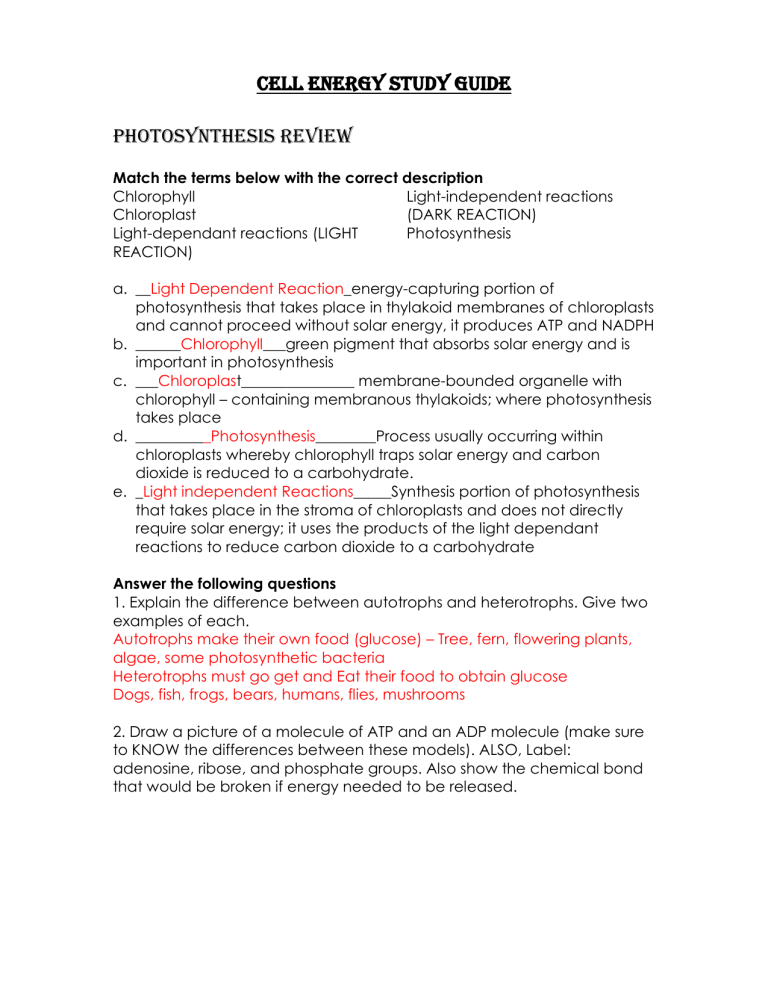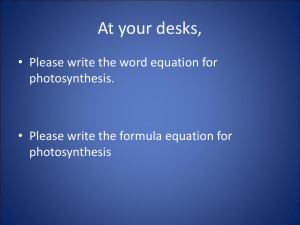
Cell Energy Study Guide Photosynthesis Review Match the terms below with the correct description Chlorophyll Light-independent reactions Chloroplast (DARK REACTION) Light-dependant reactions (LIGHT Photosynthesis REACTION) a. __Light Dependent Reaction_energy-capturing portion of photosynthesis that takes place in thylakoid membranes of chloroplasts and cannot proceed without solar energy, it produces ATP and NADPH b. ______Chlorophyll___green pigment that absorbs solar energy and is important in photosynthesis c. ___Chloroplast_______________ membrane-bounded organelle with chlorophyll – containing membranous thylakoids; where photosynthesis takes place d. __________Photosynthesis________Process usually occurring within chloroplasts whereby chlorophyll traps solar energy and carbon dioxide is reduced to a carbohydrate. e. _Light independent Reactions_____Synthesis portion of photosynthesis that takes place in the stroma of chloroplasts and does not directly require solar energy; it uses the products of the light dependant reactions to reduce carbon dioxide to a carbohydrate Answer the following questions 1. Explain the difference between autotrophs and heterotrophs. Give two examples of each. Autotrophs make their own food (glucose) – Tree, fern, flowering plants, algae, some photosynthetic bacteria Heterotrophs must go get and Eat their food to obtain glucose Dogs, fish, frogs, bears, humans, flies, mushrooms 2. Draw a picture of a molecule of ATP and an ADP molecule (make sure to KNOW the differences between these models). ALSO, Label: adenosine, ribose, and phosphate groups. Also show the chemical bond that would be broken if energy needed to be released. 3. Explain why chloroplasts are green. What is the function of chlorophyll? Chlorophyll inside of the chloroplasts of plant cells absorb all colors of light accept green. Green light is reflected at your eyes, so you see green. Chlorophyll is a pigment that absorbs the energy from sunlight. Chlorophyll is found in thylakoids which is where the light dependent reactions of photosynthesis take place 4. What is NADPH? What is the difference between NADP+, NADPH, ADP, and ATP? How does ATP turn into ADP+P? NADPH is the molecule that is formed when NADP+ picks up the Hydrogen (taken off the water plants take in) and carries it to the Calvin’s cycle (light INDEPENDENT reactions) ATP is the energy molecule made in Cell respiration- in photosynthesis ATP is used to power the Calvin’s cycle (remember the battery of photosynthesis). ATP has three phosphates. When the bond between two of those phosphates are broken, energy is released and ATP (Adenosine TRI phosphate) becomes ADP + p (Adenosine DI phosphate) ADP then goes back to the Light reactions where solar energy is used to bond ADP and the P back together to form ATP again. The cycle then repeats. See your chloroplast flip diagram to visualize this process 5. Write the chemical equation for the process of photosynthesis. YOU MUST MEMORIZE THIS 6. What are the reactants and products of Light Reaction? Where in the chloroplast do they occur? Reactants: Sunlight, Water, NADP+ ADP+p Products: Oxygen -O2 , ATP, NADPH Location: Thylakoids inside the chloroplast of plant cells 7. What are the reactants and products of Dark Reaction? Where in the chloroplast do they occur? AKA CALVIN”S CYCLE AND LIGHT INDEPENDENT REACTIONS (DON”T SAY DARK REACTIONS) Reactants: Co2 - Carbon Dioxide, ATP, NADPH Products: Glucose -C6H12O6, ADP + p, NADP+ Location: Stroma (cytoplasm of the chloroplasts) 8.Describe steps of Light-Dependent reactions. See diagram in your IAN 9.What is Light-Independent Reaction often called? Calvin’s cycle (used to also be called Dark reactions but we do not say that anymore because this can occur with or without light) 10.Where does the Carbon Dioxide come from? What will happen to it and what will it eventually become? It comes from the atmosphere (animals breathe out carbon dioxide, decaying plants and animals release it, and burning fossil fuels) It will be broken down in the Calvin’s cycle and combined with the hydrogen (taken from the water in the Light reactions) to make Glucose -C6H12O6 11.How many molecules of high-energy sugars are produced as a result of one Calvin Cycle? 1 molecule of glucose is produced in EACH Calvin Cycle 12.What happens to water, CO2, and sunlight in photosynthesis, meaning what is created from these reactants? Glucose is made, and Oxygen O2 Cellular Respiration 1. Write the overall reaction for cellular respiration. 36 ATP is made 2. What are the 3 phases of the cellular respiration process? Where does each occur in the cell? How much ATP is produced in each? What are the reactants and products in each stage? Phase Glycolysis Krebs’s cycle (AKA: Citric Acid cycle) Electron transport chain Location Cytoplasm of cells Inner membrane space of the mitochondria Inner membrane Reactants Glucose Products 2 pyruvic acids 2 pyruvic acids Citric acid Oxygen and electrons Water and ATP ATP Produced 2 2 36 (on the membrane) of the mitochondria Remember GIANTS KILL ELVES and 2-2-32 3. How many ATP are produced in cell respiration from one glucose molecule? 36 4. In which phase of cellular respiration is carbon dioxide made? SKIP 5. In which phase of cellular respiration is water made? Electron Transport chain 6. In which phase of cellular respiration is oxygen a reactant? Krebs’s and Electron transport chain 7. In which phase of cellular respiration is glucose a reactant? Glycolysis 8. What steps does Aerobic Respiration consist of? Krebs’s and Electron transport chain (BOTH require oxygen) 9. What steps does Anaerobic Respiration consist of? Glycolysis – no oxygen is required 10. Out of Aerobic and Anaerobic Respiration which process makes the most ATP for the cell? What is the difference between the two? Name the steps of each. Aerobic!!!!!! Glycolysis – no oxygen = anaerobic Krebs’s – Aerobic = oxygen is required Electron Transport Chain – Aerobic = oxygen is required 11. Name the two types of fermentation. What is the difference between the two? Where are they found to occur? Lactic Acid Fermentation – your cells do this when there is no oxygen left to perform the Krebs’s cycle – hurts – muscle soreness, burn, and side pain when running Alcohol fermentation – how yeast and other organisms ferment (alcohol and bread are made using alcohol fermentation) Along with the study guide, review all of your notes given on photosynthesis, cell respiration and fermentation. And use your IAN


